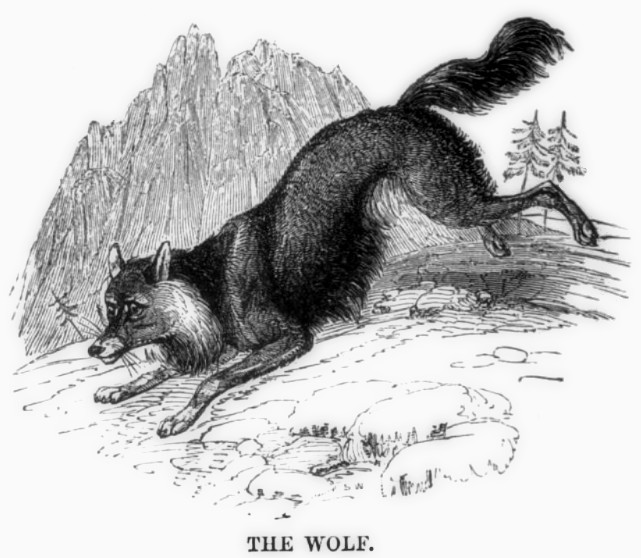Is It a Werewolf Story If There’s No Werewolf?
“A Story of a Weir-Wolf” (1846) is probably one of Catherine Crowe’s best known short works because it shows up in a fair number of werewolf fiction anthologies. But there’s not really a werewolf in it — just a character falsely accused of this branch of witchcraft. You see, the story is set in 1596, and this is long before Hollywood put a vampire-spin on werewolves by making the bite of one responsible for the creation of another one. Way back when, a person chose to become a werewolf for the naughty fun of it — but it required a dark ritual and possibly some dealing with the Devil. As I say, though, that’s not what happens in Crowe’s tale.

In fact, “Weir-Wolf” is better understood as a supernatural-free story. Even an alchemist, named Michael Thilouze, never gets the elixir of youth he pursues — but his Faustian attempt to do so might be seen as the root of the trouble he brings upon himself and his daughter, Francoise. To understand this, one must sort out a complicated tangle of love and resentment.
Stay with me. Victor de Vardes is “arranged” to marry Clemence de Montmorenci — but he thinks Manon Thierry is mighty fine — until he spots Francoise and these two fall in love. This makes Manon surly. Meanwhile, Jacques Renard is also “extremely in love with the alchemist’s daughter,” so he’s surly, too. Oh, and woodsy Pierre Bloui “was a suitor for Manon’s hand,” but she’s more focused on the situation between Victor and Francoise. It’s a novel’s worth of love complications packed into a short story, and I had to scribble down a chart to keep these relationships straight.
With all this jealousy panging left and right, there’s going to be trouble. Sure enough, Renard spills the beans to Count de Vardes, Victor’s father, who wants his son to marry well. And how did the lad’s affections jump from the blue-blooded Clemence over to some baseborn alchemist’s daughter? Did Francoise put the love whammy on Victor? Gossip spreads. Speculation rises. Crowe tells us:
It was asserted that [Pierre] had frequently met Victor and Francoise walking together, in remote parts of the domain; but that when they drew near, she suddenly changed herself into a wolf and ran off. It was a favourite trick of witches to transform themselves into wolves, cats, and hares, and weir-wolves were the terror of the rustics; and as just at that period there happened to be one particularly large wolf, that had almost miraculously escaped the forester's guns, she was fixed upon as the representative of the metamorphosed Francoise.
Around here, Crowe tosses out the date 1588, which confused me at first because she opens by setting the story eight years later. But Crowe knew her werewolf-related lore — see, for instance, her essay “The Lycanthropist” — and 1588 is a quick allusion to a famous witch/werewolf case that occurred in Aubergne, France. This bit of folklore involves a hunter cutting off a wolf’s paw and then tracing it to a woman with a bloody stump, the latter then being tried and executed for her crime. The event was generally known in England during Crowe’s era, as shown here, here, and here, and it was almost certainly the inspiration for her “Weir-Wolf.” As we’ll see, Crowe seems to be radically retelling this tale to make a very different point.
Pierre traps the wolf, but it escapes by sacrificing its paw. Shortly afterward, Francoise is found to be one hand short! A wild coincidence? Oddly enough, yes! We learn later, though, that Francoise’s amputation is related to Michael’s efforts to attain his elusive elixir, thereby making him indirectly responsible for the father and daughter being “found guilty of abominable and devilish magic arts.” Readers know they’re innocent, but fret not — there’s an interesting twist coming.
An Interesting Twist (and Big Spoilers)
A crowd has gathered to enjoy the execution of Michael and Francoise. The father and daughter stand by a pile of kindling. The executioner is about to strike a match. However, rather than rely on what some might consider a conventional hero such as Victor coming to the rescue, Crowe gives us something less “happily-ever-after” and more meaningful.
Manon, you see, has grown to regret the will ill she felt for Francoise. She hopes to make amends and settles on a plan:
This was no other than to shoot the wolf herself, and, by producing it, to prove the falsity of the accusation. For this purpose, she provided herself with a young pig, which she slung in a sack over her shoulder, and with her brother's gun on the other, and disguised in his habiliments, when the shadows of twilight fell upon the earth, the brave girl went forth into the forest on her bold enterprise alone.
Indeed, at the crucial moment, “there came forward, slowly and with difficulty, pale, dishevelled, with clothes torn and stained with blood, Manon Thierry, dragging behind her a dead wolf.” Francoise and the wolf are not one and the same! The crowd cries for their pardon and release!
We’re not done, however. Crowe shows that, while one woman’s valiant effort to provide proof positive should be enough, it isn’t. It isn’t in 1596 France, and very likely, it isn’t among British readers in 1846. It takes Victor’s arrival with a pardon-on-paper from the King himself to finally release the falsely accused pair from their death sentences. Elaborating and revising the folktale about the werewolf of Aubergne, Crowe illustrates how women can be determined and powerful and capable — and rigidly dismissed by men in charge.
